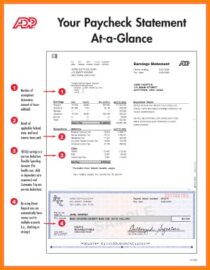
It measures profit after considering all operational expenses, including manufacturing costs, promotional expenses, R&D and administrative costs. At the same time, it excludes non-operating costs and income that can obscure the performance of the company’s core business. D Trump footwear company earned total sales revenues of $25M for the second quarter of the current year. As a result, the income before taxes derived from operations gave a total amount of $9M in profits. Operating income demonstrates the business’s ability to generate profit from its core operations after covering its operating expenses.
Healthpeak Earnings: Same-Store Net Operating Income Better … – Morningstar
Healthpeak Earnings: Same-Store Net Operating Income Better ….
Posted: Tue, 01 Aug 2023 17:56:14 GMT [source]
External stakeholders—like investors or creditors—will want to evaluate your income statement before deciding to work with you. The Internal Revenue Service (IRS) will also need to see an income statement to determine your total taxable business income. The main thing you can learn from an income statement is how much money your business earned, and how much money your business spent to earn it. Your income statement lets you see your business’s financial health, so you can set realistic and helpful goals and budgets for the future—and see if those efforts have been successful.
Operating Income Formulas and Calculations
In other words, it looks like UPS failed to run a more profitable shipping business in 2022. Instead, the company boosted its operating profits in 2022 by holding back on capital expenses and other accounting tricks. You start the NOI calculation from gross profits (revenues minus cost of revenues) and then subtract the direct operating costs involved in earning that revenue. Operating income doesn’t include non-operating expenses such as restructuring expenses, interest, lawsuits and inventory charges. This value also commonly strikes comparisons to earnings before interest and taxes (EBIT), but the two differ in that EBIT includes non-operating income. It’s best to use multiple metrics such as EBIT, operating income, and net income to analyze a company’s profitability.
It also includes other forms of income including non-operating income and non-operating expenses. Some examples of non-operating expenses could include things like interest payments, taxes, lawsuit settlements, or restructuring costs. An income statement, also known as a profit and loss statement (P&L statement), summarizes a business’s revenues and expenses over a period of time. It’s one of the most important financial statements for small business owners, so it’s key to understand what an income statement is, what its purpose is, and how to read one. Operating income is only one of several key business profit metrics, along with gross margin and net income.
Operating Income Examples
Operating income indicates how profitable a company will be after it has deducted operational expenses and cost of goods sold (COGS). This measurement doesn’t include non-operating expenses like inventory costs or interest, and it also excludes taxes. A higher operating income usually means a company will be more profitable, while a lower operating income indicates less profitability. Operating income is similar to a company’s earnings before interest and taxes (EBIT); it is also referred to as the operating profit or recurring profit. Both measurements calculate the amount of money a company earned less a few noncontrollable costs.

The calculation itself is simple, but figuring out the operating expenses can take a little longer. It’s also possible to take total revenue into consideration instead of just gross income. As you can see, fuel costs skyrocketed in 2022, while other operating costs trended higher due to global inflation.
Operating Income vs. Gross Profit
Operating income excludes taxes and interest expenses, which is why it’s often referred to as EBIT. Operating income is what is left over after a company subtracts the cost of goods sold (COGS) and other operating expenses from the sales revenues it receives. However, it does not take into consideration taxes, interest or financing charges. It’s important to note that operating income is different than net income. Operating income includes expenses such as costs of goods sold and operating expenses. However, operating income does not include items such as other income, non-operating income, and non-operating expenses.
- Also, EBIT strips out the cost of debt (or interest expense), which is deducted from revenue to arrive at net income.
- Revenue from real estate includes rental income, parking fees, service changes, vending machines, laundry machines, and so on.
- These articles and related content is not a substitute for the guidance of a lawyer (and especially for questions related to GDPR), tax, or compliance professional.
- This value doesn’t include taxes, and it indicates how profitable a company can be after deducting operational activity costs.
Operating income represents the profit a company has after paying for all expenses related to core operations. Two of the most common reportable income figures are gross profit and operating income. Though similar, both shine a different light on certain aspects of a business. The main difference is that gross income is the total revenue minus the COGS. In short, high operating income can indicate that a company is profitable, but it’s not always the case. High operating income usually means that a company is profitable, but there may be cases where a business needs to pay more in taxes and interest.
Nonoperating Revenue
It’s critical to document and include these expenses so your net income calculations are accurate. For a deeper dive into how to prepare financial statements, like an income statement and a balance sheet, check out our video on bookkeeping! The five bookkeeping steps we go over will help you get the most out of your income statement, and beyond. This can be an easier way to understand how efficiently the company generates profits from its core business, as you can compare year-over-year or versus competitors. The income statement ends with net income, also called profit or “the bottom line.” This is the amount of money left after subtracting all expenses. The biggest non-operating expense items are taxes and interest, but there’s also a category called « other (non-operating) income or expenses. »

Analyzing operating income is helpful to investors because it doesn’t include taxes and other one-off items that might skew profit or net income. Companies must factor in a number of expenses to run a business, and sometimes these costs exceed revenues, resulting in lower operating income and profit. When a company has healthy revenues and operating income, this results in stronger operating margins. However, what is considered a strong operating margin often varies across different industries. Net operating income (NOI) is a calculation used to analyze the profitability of income-generating real estate investments.
Operating income, operating profit, and earnings before interest and taxes (EBIT) are all terms that relate to the earnings of a business. These terms are sometimes used interchangeably as they generally refer to the same concept, though there are slight differences in how each of these terms may be interpreted. Your revenue (aka income) is how much money your business earns from goods and services. This includes “operating” revenue, which is the revenue you make from selling goods and services, and “non-operating” revenue, which you make through behind-the-scenes operations, like maintenance. Like an income statement, a balance sheet also gives you a look into your business’s finances for a specific period of time. However, balance sheets are usually for a specific date, while income statements are for longer periods, like a month, quarter, or year.
No, operating income is the income generated by core business activities and doesn’t account for variables like taxes and interest payments. Net income is the “bottom line” for a company’s finances — all income left over after every obligation and expense is paid. Operating income helps you understand how well the company is running its core operations, before financial costs like capital structure and taxes are deducted. Operating income is the profit a company is left with after paying for all expenses related to core business operations. It’s a simple way to measure performance year-over-year or to compare one business to another.
Operating Income vs. Revenue
The bottom line is also referred to as net income on the income statement. While a good operating income is often indicative of profitability, there may be cases when a company earns money from operations but must spend more on interest and taxes. This could be adp prepaid mastercard for parking and transit due to a one-time charge, poor financial decisions made by the company, or an increasing interest rate environment that impacts outstanding debts. Alternatively, a company may earn a great deal of interest income, which would not show up as operating income.

In general, a company must have enough operating profit to cover taxes and interest expenses to break even. Negative operating income means the company will require funding to maintain business operations. A company’s finance team will also use operating profit when reviewing spending and budgeting. Operating income is a great way to test profitability when compared to sales, and finance teams can use it to determine how well a company manages operating expenses.
Net income is calculated by netting out items from operating income that include depreciation, interest, taxes, and other expenses. Sometimes, additional income streams add to earnings like interest on investments or proceeds from the sale of assets. In contrast to operating income, non-operating income is the portion of an organization’s income that is derived from activities not related to its core business operations. It can include items such as dividend income, interest, gains or losses from investments, as well as those incurred in foreign exchange and asset write-downs. To calculate net operating income, subtract operating expenses from the revenue generated by a property.